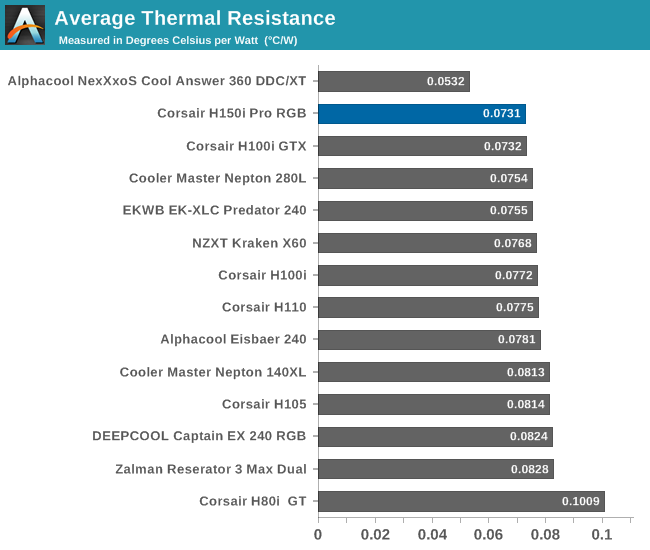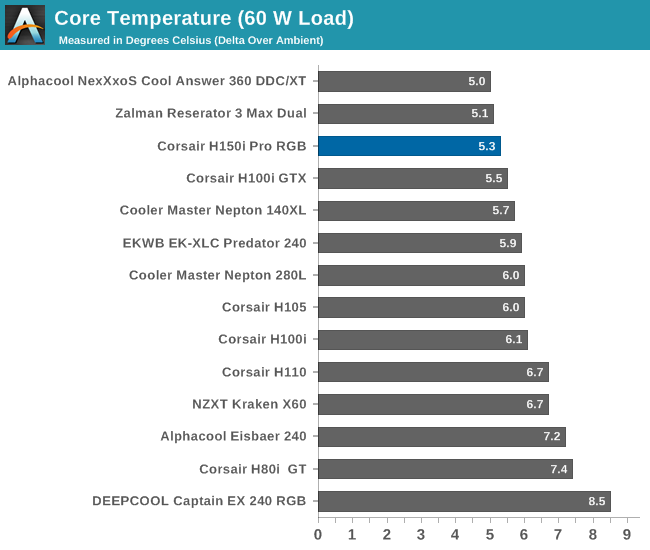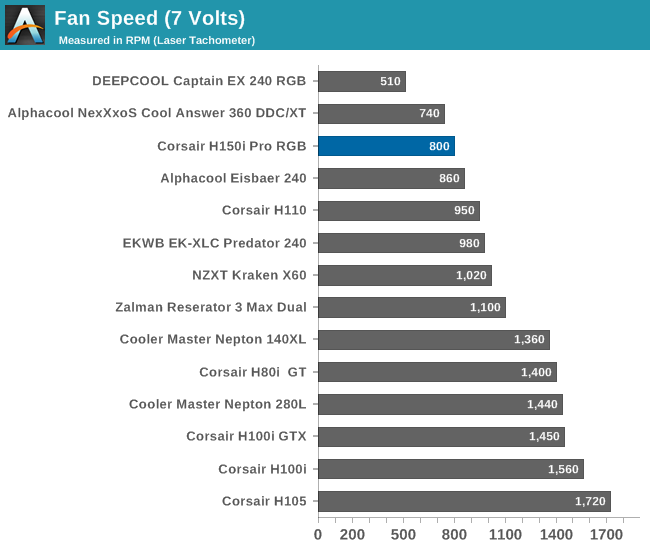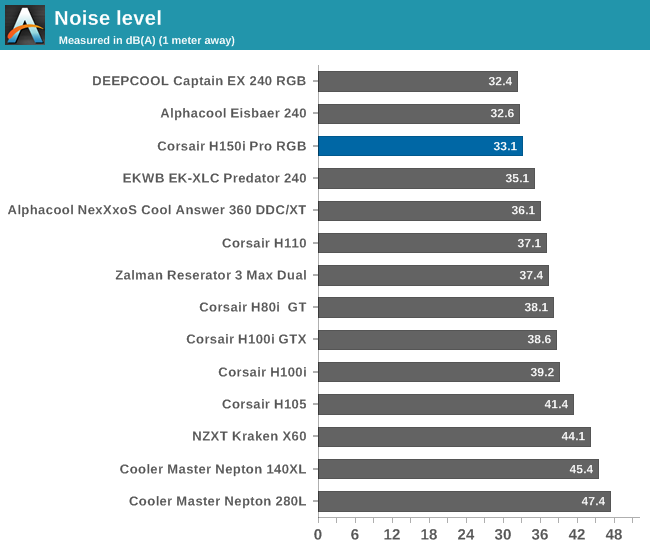The Corsair H150i Pro RGB AIO Cooler Review: The Quiet Giant
by E. Fylladitakis on August 16, 2018 8:00 AM ESTTesting Results, Low Fan Speed
Using a PWM voltage regulator, we reduced the speed of the fans manually down to half their rated speed, which is 800 RPM. The pump was also connected on the same power source, functioning properly at this low speed setting.


| Core Temperature, Constant Thermal Load (Low Fan Speed) |
The Corsair H150i Pro RGB is doing much better in this test, managing to almost match the thermal performance of larger (and much more expensive) liquid coolers. Both the low and high load thermal performance of the H150i Pro RGB are exceptional, outpacing most of the smaller AIO cooler implementations. The average thermal resistance is 0.0837 °C/W, hardly worse than the figures we recorded with the cooler's fans running at maximum speed.

Under these operating conditions, we recorded a sound pressure reading of just 33.1 dB(A), a very low figure for any kind of CPU cooler. The H150i Pro RGB will virtually be imperceptible with its fans running at 800 RPM inside a typical room. A slight humming sound will be perceptible in a quiet environment but its intensity is very low and certainly tolerable by even the most sensitive-eared users.











42 Comments
View All Comments
Wolfclaw - Friday, August 17, 2018 - link
I'll stick to my Arctic 240 with its 4 fans, £75 and keeps my R5-2600 cool and quiet !imaheadcase - Friday, August 17, 2018 - link
I'm actually surprised Intel and AMD just don't ship small water AIO with retail cpu by now. I guess they are still afraid of the old "it has water it can mess stuff up" mentality.Oxford Guy - Friday, August 17, 2018 - link
AMD did that with the 9590.Icehawk - Saturday, August 18, 2018 - link
I believe Intel also offered them at one point - not very good ones though.Orange_Swan - Tuesday, August 21, 2018 - link
to be fair with a 225w tdp it was probably cheaper than building a comparable air coolernpp - Friday, August 17, 2018 - link
"The noise floor of our recording equipment is 30.2-30.4 dB(A), which represents a medium-sized room without any active noise sources."This is false and misleading, as is the whole table stating among others that anything below 35dBa is "virtually inaudible".
Really sad that silentpcreview.com is gone now, as are the days when such dubious and downright erroneous statements wouldn't have made their way into an anandtech review.
Oxford Guy - Friday, August 17, 2018 - link
My favorite example is when the same review site that glosses over fan noise later gushes about the silence afforded by a fanless PC. Which is it? Either all those fans are "silent" and "inaudible" or they're not.Tell a tinnitus sufferer about silent PC fans. It is, for instance, very possible for a person to be able to tolerate many, much louder, sounds — like air conditioner fans and car trip noise, and yet get much worse tinnitus reaction problems from these supposedly silent/quiet/inaudible PC parts.
I've been waiting many years for a high-performance fanless case but it looks like the lastest one, the Calyos, is vaporware. Apparently, the designers have moved to a new startup to create more vaporware, albeit with worse specs.
Ryan Smith - Friday, August 17, 2018 - link
So the standard that is usually quoted for a quiet room in a rural area is 30 dB(A).http://www.dot.ca.gov/dist2/projects/sixer/loud.pd...
In practice you won't find that rooms can get much quieter than that without using sound-absorbing designs, be it a recording studio or anechoic chamber.
Now if you have findings that say otherwise, we're more than happy to look at them. After all, we strive for accuracy. But what I can say for certainty is that none of our testing environments get below 30 dB(A).
npp - Friday, August 17, 2018 - link
Ryan, this a review of the legendary Scythe Ninja done by SPCR in 2005, long before they built their hemi-anechoic chamber:https://bit.ly/2MA3g5E
As you can see, the ambient SPL was 18dBA (without room treatment) and the fan did rise up to about 22dBA, which according to the quoted data should be inaudible. Of course, if the noise floor in the room is 30dBa, one could go on and state that the cooler is silent, and this wouldn't be true.
I'm not trying to argue or split hairs here, but if you want to include SPL measurements, you should take them more seriously. A room with 30dBa noise floor isn't the best place to perform such measurements to begin with and makes judgement of the sound performance of various fans highly unreliable.
Now regarding what constitutes a quite room, this is really a subjective matter. The common consensus is around 20-30dBA, I personally would call 20dBa quite enough.
Diji1 - Friday, August 17, 2018 - link
>A room with 30dBa noise floor isn't the best place to perform such measurementsFair point but it's not as though most users are going to be using the product in super quiet spaces like that.